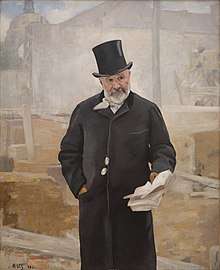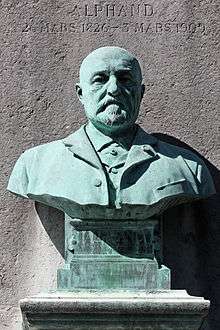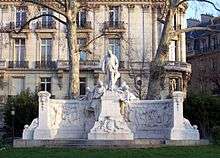Adolphe Alphand
| Jean-Charles Adolphe Alphand | |
|---|---|
 Portrait of Jean-Charles Alphand (1888), by Alfred Philippe Roll | |
| Born |
October 26, 1817 Grenoble |
| Died |
December 6, 1891 Paris |
| Resting place | Père Lachaise Cemetery |
| Occupation | French engineer of the Corps of Bridges and Roads |


Jean-Charles Adolphe Alphand (French pronunciation: [ʒɑ̃ ʃaʁl adɔlf alfɑ̃]), born in 1817 and died in 1891, interred at Père Lachaise Cemetery (division 66), was a French engineer of the Corps of Bridges and Roads.
Life and career
Born in Grenoble, Alphand entered the École polytechnique in 1835 and continued his engineering studies at the prestigious École des ponts et chaussées in 1837. He began his career as an engineer in the coastal city of Bordeaux, working on improvements to the port, railways, and other infrastructure. It was in Bordeaux that Alphand met and earned the trust of Baron Haussmann, who was the Prefect of the Gironde province. In 1854, the year after Haussmann was promoted to the powerful role of Prefect of the Seine (Paris) by Napoleon III, Haussmann hired Alphand as chief engineer of the Bois de Boulogne, a role which soon expanded into director of the newly formed parks department (Service des Promenades et Plantations), and later into an all-around director of public works. Under Napoléon III, Alphand participated in the renovation of Paris directed by Baron Haussmann between 1852 and 1870, in the company of another engineer Eugène Belgrand and the landscape architect Jean-Pierre Barillet-Deschamps.
He created walks, parks and gardens designed to embellish and sanitize Paris. He also remodeled the Bois de Vincennes and Bois de Boulogne.
Adolphe Alphand's notable accomplishments include:
- The Square du Temple
- The Paris Observatory Avenue (Avenue de l'Observatoire)
- The gardens of Champs-Élysées
- Parc Monceau
- Boulevard Richard-Lenoir
- Bois de Vincennes
- Parc Montsouris
- Bois de Boulogne
- Parc des Buttes-Chaumont
- Square des Batignolles
- Jardin des Plantes du Mans
After the retirement of Baron Haussmann, his successor, Léon Say, entrusted to Alphand the position of Director of Public Works of Paris. Under this title, Alphand continued Haussmann's works. Alphand also became the Director of Water Works after the death of Eugène Belgrand in 1878. In particular, Alphand directed the construction of:
- The fortifications of Paris
- The Trocadéro Gardens, carried out for the Paris Universal Exposition of 1878
- Preparation for the Universal Exposition of 1889
- The promenade and the gardens of Paris's Hôtel de Ville
Bibliography
- Alphand, Adolphe (1867-1873). Les Promenades de Paris. Texte [Text]. Rothschild.
- Alphand, Adolphe (1867-1873). Les Promenades de Paris. Planches [Plates]. Paris: Rothschild.
- Alphand, Adolphe (1984). Les Promenades de Paris. New York, New York: Princeton Architectural Press. ISBN 0-910413-06-1. Reprint. Originally published Paris : Rothschild, 1867-1873.
References
- ↑ This monument is the work of sculptor Aimé-Jules Dalou and architect Jean-Camille Formigé. It is located between 17-22 Avenue Foch.
- ↑ IPNI. Alphand.
- Fierro, Alfred (1999). "Buttes-Chaumont". Life and History of the 19th Arrondissement. Paris: Editions Hervas. pp. 80–100. ISBN 2-903118-29-9.
Further reading
- Downie, David (2005). "Montsouris and Buttes-Chaumont: the art of the faux". Paris, Paris: Journey into the City of Light. Fort Bragg: Transatlantic Press. pp. 34–41. ISBN 0-9769251-0-9.
- Hopkins, Richard S. (2015). Planning the Greenspaces of Nineteenth-Century Paris. Baton Rouge: Louisiana State University Press. ISBN 0807159867, 9780807159866.
- Jordan, David P. (1995). Transforming Paris: The Life and Labors of Baron Haussmann. New York: Simon and Schuster. ISBN 0029165318, 978-0029165317.
- Komara, Ann (2004). "Concrete and the Engineered Picturesque the Parc des Buttes Chaumont (Paris, 1867). Journal of Architectural Education Vol. 58, No. 1, Construction and Context (Sep., 2004), pp. 5-12.
- Komara, Ann (2009). "Measure and Map: Alphand's Contours of Construction at the Parc des Buttes Chaumont, Paris 1867." Landscape Journal Vol. 28, No. 1 (2009), pp. 22-39
- Picon, Antoine. "Nineteenth-Century Cartography and the Scientific Ideal: The Case of Paris." Osiris Vol 18 (2003), pp 135–149. University of Chicago Press.